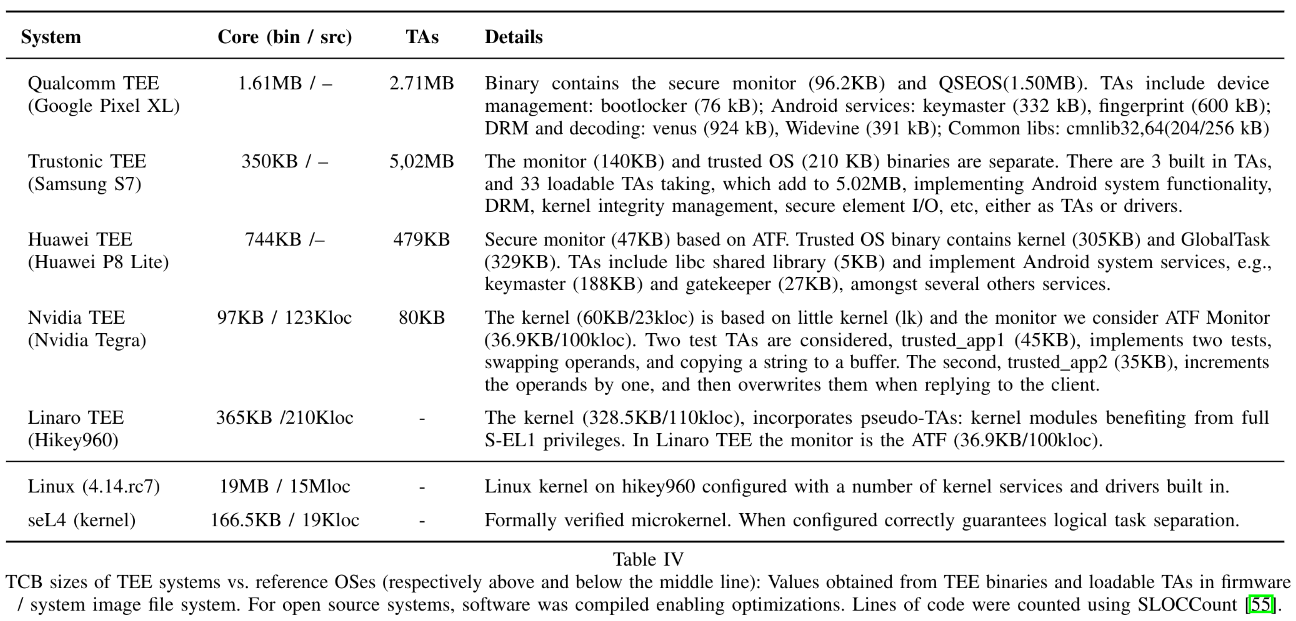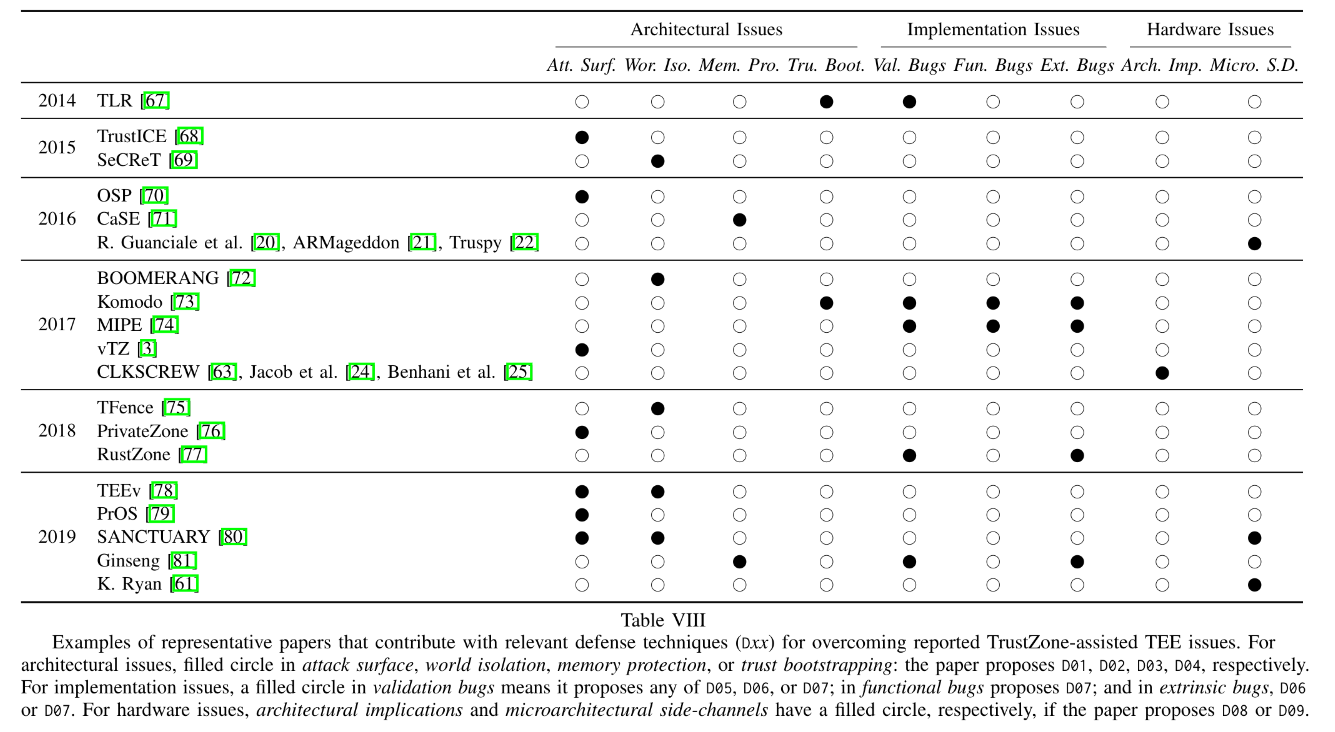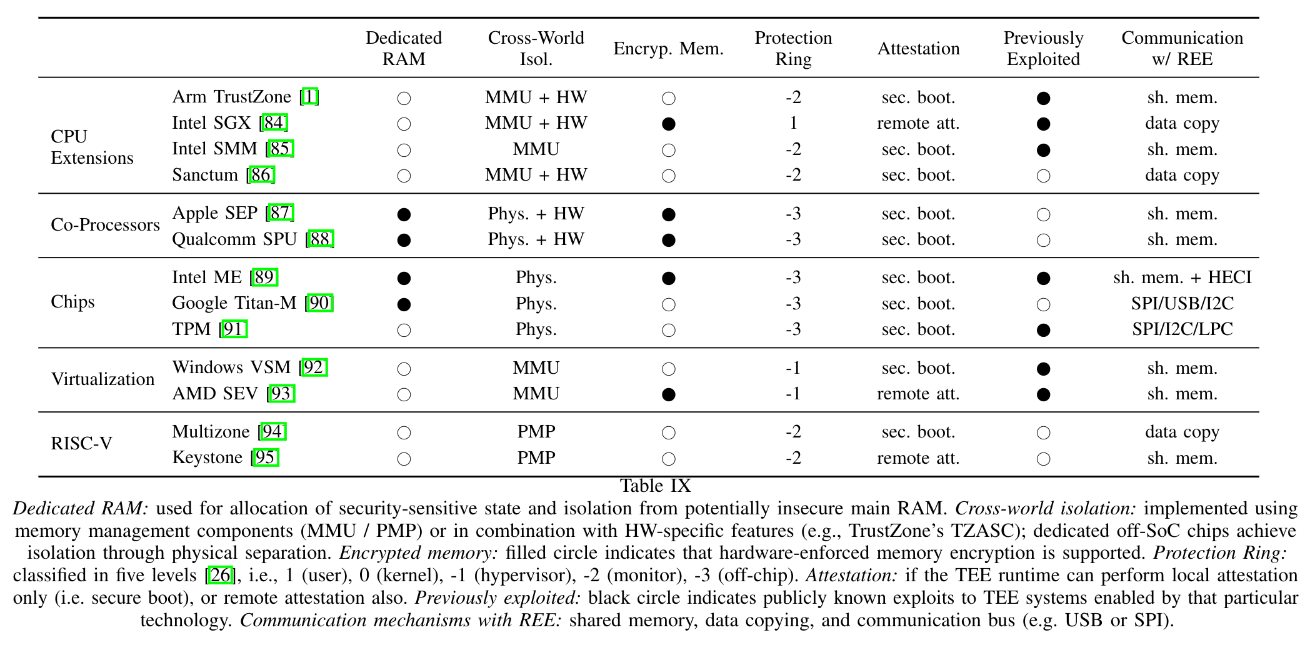这是一篇IEEE S&P 2020的论文,这篇文章中,作者通过分析过去几年内TrustZone的TEE有关的上百个漏洞,分析存在的安全问题。
- 列举了很多漏洞成因,部分攻击还举例了相关的工作。
- 列举出了近几年的一些的防御工作
总览
分析方法论
攻击的威胁模型:提出了4个不同程度的威胁模型,表示这些漏洞致力于其中的一些目标
被分析的TEE实现: Qualcomm, Trustonic, Huawei, Nvidia, and Linaro.
漏洞数据来源:CVE (CVE databases), SVE (SVE databases), SP (scientific publications), MR (miscellaneous reports), and SC (source code, for OP-TEE only)
漏洞分级:表格列举了对已被分配CVE的漏洞的严重等级分布
二进制分析:对TEE系统中的子集进行二进制分析
- 量化每个TEE系统的TCB范围
- 确定具体的软件架构
- 分析每个TEE实现的内存保护功能
对于每个TEE系统只逆向分析了其中的某个版本
对结论的有效性的威胁:由于缺乏POC和CVE描述的不准确,作者对漏洞的分类可能是不准确的。
漏洞原因
architectural issue
作者列出了调研的TEE系统的结构

TEE的攻击面
- T01. SW drivers run in the TEE kernel space
- 安全世界中的驱动可能是脆弱的但是具有较高的权限级
- I02. Wide interfaces between TEE system subcomponents
- NW中的kernel暴露了太多的接口给普通程序
- SW中的kernel给NW的kernel暴露了很多的SMC调用
- TA给CA暴露了很多cmd
- SW中的kernel给TA暴露了很多syscall并且很少做限制
- I03. Excessively large TEE TCBs
TEE世界中的代码量很大,作者用了一张表格来表示

NW和SW之间的隔离
- I04. TAs can map physical memory in the NW
- 由于对高效的共享内存机制的需求,一些TEE kernel如QSEE提供系统调用让TA映射任意的NW中的内存
- I05. Information leaks to NW through debugging channels
- 一些对TA的调试机制如dump stack trace到NW,将log提供给NW能导致地址信息泄露
内存保护机制

- I06. Absent or weak ASLR implementations
- ASLR机制实施不完善,有些TEE中TA被加载到固定的位置
- I07. No stack cookies, guard pages, or execution protection
可信启动
- I08. Lack of software-independent TEE integrity reporting
- 尽管存在安全启动,但是缺乏向远程第三方安全地报告软件完整性测量结果的硬件机制
- I09. Ill-supported TA revocation
- 无法正确地处理TA撤销,易受到降级攻击
implementation issue
验证错误Validation Bugs
Examples include buffer overflows, incorrect parameter validation, mishandled integer overflows, etc.
- I10. Validation bugs within the secure monitor
- I11. Validation bugs within TAs
- I12. Validation bugs within the trusted kernel
- I13. Validation bugs in secure boot loader
功能性错误Functional Bugs
- I14. Bugs in memory protection
- I15. Bugs in configuration of peripherals
- I16. Bugs in security mechanisms
外部错误Extrinsic Bugs
- I17. Concurrency bugs
- 并发访问文件系统(OP-TEE)
- TOCTOU漏洞,系统状态的某些方面在条件检查后发生变化(Trustonic、Nvidia)
- I18. Software side-channels
hardware issue
架构影响Architectural Implications
- I19. Attacks through reconfigurable hardware components
- 一些reconfigurable的平台如FPGA上特有的问题
- I20. Attacks through energy management mechanisms
- 通过在NW侧调节频率和电压在SW中诱发错误的计算
微体系结构侧信道
- I21. Leaking information through caches
- I22. Leaking information through branch predictor
- I23. Leaking information using Rowhammer
防御工作

体系结构防御Architectural Defenses
- D01. Multi-isolated environments
- 在NW中创建隔离环境
- 利用TZASC:SANCTUARY、TrustICE
- NW中的硬件虚拟化扩展:OSP、PrivateZone、vTZ
- 加强SW中TA的隔离
- 在SW中实现minimalist hypervisor:TEEv、PrOS
- 并未使用SW中的硬件虚拟化支持
- 在SW中实现minimalist hypervisor:TEEv、PrOS
- 在NW中创建隔离环境
- D02. Secure cross-world channels
- 创建安全的NW-SW通道
- D03. Encrypted memory
- D04. Trusted computing primitives
实现上的防御Implementation Defenses
- D05. Managed code runtimes
- D06. Type-safe programming languages
- RustZone
- D07. Software verification
- 对特定的组件进行形式化验证
硬件防御Hardware Defenses
- D08. Architectural countermeasures
- D09. Microarchitectural countermeasures
除TrustZone之外的安全硬件技术
